Themed collection Polymer Chemistry Emerging Investigators Series

Nanoconfined polymerization: advantages of lyotropic liquid crystals as soft templates
Impact of confinement on kinetics of free radical polymerization, linking geometrical constraints and physiochemical effects to polymerization steps.

Polym. Chem., 2025,16, 1427-1440
https://doi.org/10.1039/D4PY01470G
Panoramic view of biobased BHMTHF-based polymers
BHMTHF, also known as THFDM, is a biobased monomer that is utilized in the synthesis of polyesters and polyurethanes with unique properties. This review highlights the synthesis and structure-property relationship of these interesting polymers.

Polym. Chem., 2025,16, 3587-3596
https://doi.org/10.1039/D5PY00544B
Unravelling the mechanisms of nanomedicines: analytical tools to characterise the interaction between synthetic macromolecules and lipid membranes
A comprehensive overview of analytical techniques for probing polymer–membrane interactions, enabling a mechanistic understanding essential for advancing polymer-based nanomedicines.

Polym. Chem., 2026, Advance Article
https://doi.org/10.1039/D5PY00850F
Thermoresponsive hydrogels incorporating phase-change energy storage materials for advanced thermal management
This review summarizes the latest advancements in phase-change hydrogels, covering synthesis, thermal responsiveness regulation, and applications.

Polym. Chem., 2025,16, 3379-3395
https://doi.org/10.1039/D5PY00318K
Harnessing enzymes for greener polymerisations: advances in chain and step growth processes
This review aims to guide polymer chemists in adopting enzymatic catalysis for sustainable polymer synthesis, highlighting enzymes as powerful tools.

Polym. Chem., 2025,16, 2997-3029
https://doi.org/10.1039/D5PY00223K
Synthesis and applications of conjugated main-chain charged polyelectrolytes
The synthetic methods and applications of conjugated main-chain charged polyelectrolytes (CMCPs) with different cationic structures are summarized in this review to facilitate the development of more diversified CMCPs with advanced functionalities.

Polym. Chem., 2025,16, 923-935
https://doi.org/10.1039/D4PY01405G
Covalent adaptive networks with repairable, reprocessable, reconfigurable, recyclable, and re-adhesive (5R) performance via dynamic isocyanate chemistry
Recent developments and challenges in covalent adaptive networks with repairable, reprocessable, reconfigurable, recyclable, and re-adhesive (5R) performance via dynamic isocyanate chemistry are summarized in this review article.
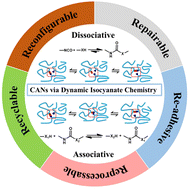
Polym. Chem., 2023,14, 4381-4406
https://doi.org/10.1039/D3PY00944K
Water treatment using stimuli-responsive polymers
Stimuli-responsive polymers are a new category of smart materials used in water treatment via a stimuli-induced purification process and subsequent regeneration processes.

Polym. Chem., 2022,13, 5940-5964
https://doi.org/10.1039/D2PY00992G
State-of-the-art, opportunities, and challenges in bottom-up synthesis of polymers with high thermal conductivity
The ongoing research activities in the fields of bottom-up synthesis of thermally conductive polymers and thermal transport mechanisms in polymers are reviewed. Perspectives on developing polymers with high thermal conductivities are discussed.
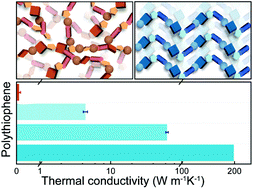
Polym. Chem., 2022,13, 4462-4483
https://doi.org/10.1039/D2PY00272H
Organic–inorganic hybrid nanomaterials prepared via polymerization-induced self-assembly: recent developments and future opportunities
This review highlights recent developments in the preparation of organic–inorganic hybrid nanomaterials via polymerization-induced self-assembly.

Polym. Chem., 2022,13, 2554-2569
https://doi.org/10.1039/D2PY00180B
Recent advances in the preparation of semifluorinated polymers
Synthesis of semifluorinated polymers containing fluorous groups on the backbone or as side chains is an increasingly popular field of research.
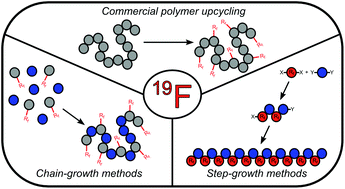
Polym. Chem., 2021,12, 6515-6526
https://doi.org/10.1039/D1PY01024G
Photothermally-driven cobalt catalysed atom transfer radical polymerisation enables isocyanide copolymer synthesis
A vitamin B12-derived photothermal catalyst enables controlled isocyanide copolymerization, synthesis of block copolymers, and temporal control via ATRP, while outperforming conventional systems under white light irradiation.

Polym. Chem., 2025,16, 2811-2816
https://doi.org/10.1039/D5PY00422E
Towards degradable and functionalizable polymers: alternating ring-opening metathesis copolymerization of oxanorbornadiene dicarboxylate and 2,3-dihydrofuran
A degradable and functionalizable polymer, capable of post-polymerization modification, was developed through the alternating ring-opening metathesis copolymerization of commercially available oxanorbornadiene and 2,3-dihydrofuran.

Polym. Chem., 2025,16, 1647-1652
https://doi.org/10.1039/D5PY00176E
Room-temperature magnetism in the crystal of a 1,6-heptadiyne derivative and its processable polymer
The black powder of a poly[1,6-heptadiyne] derivative demonstrates room-temperature ferromagnetism, a rare attribute in conjugated polymers.

Polym. Chem., 2025,16, 1120-1125
https://doi.org/10.1039/D4PY01459F
Increasingly threaded polypseudorotaxanes with reduced enthalpies of melting
We used acyclic diene metathesis (ADMET) chemistry to prepare variably threaded pseudopolyrotaxanes. We find that the melting enthalpy decreases as the number density of macrocycles is increased.

Polym. Chem., 2025,16, 112-116
https://doi.org/10.1039/D4PY01006J
Therapeutic applications of responsive organic photocatalytic polymers, enabling in situ drug activation
Targeted prodrug activation within the acidic tumour microenvironment using pH-responsive photocatalytic nanomaterials.

Polym. Chem., 2024,15, 3223-3228
https://doi.org/10.1039/D4PY00493K
Tröger's base-containing fluorenone organic polymer for discriminative fluorescence sensing of sulfamethazine antibiotic at ppb level in the water medium
A new Tröger's base containing fluorenone organic polymer (TB-FL-COP) was synthesized and used as a fluorescence sensor for discriminative sensing of antibiotics in water.

Polym. Chem., 2023,14, 4153-4159
https://doi.org/10.1039/D3PY00857F
Expedient synthesis and ring-opening metathesis polymerization of pyridinonorbornenes
Pyridinonorbornenes, a unique family of ROMP monomers, were synthesized via the intermediacy of 2,3-pyridynes. Modulation of the steric hindrance about the nitrogen allowed a living ROMP process and the production of polymers with high Tg and Td.
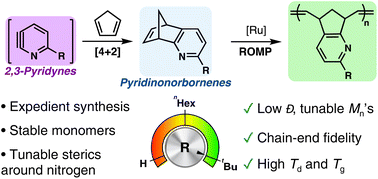
Polym. Chem., 2022,13, 5530-5535
https://doi.org/10.1039/D2PY00857B
Peptide based folding and function of single polymer chains
A modular synthetic strategy to fold single polymer chains upon deprotection of pendent cysteine terminal peptides is reported. The one step deprotection initiates both folding and catalytic activity of the macromolecular architectures.
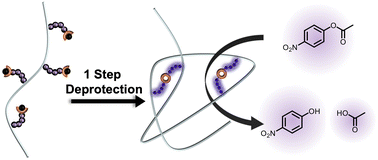
Polym. Chem., 2022,13, 5458-5462
https://doi.org/10.1039/D2PY00717G
Tailoring the luminescence of FRET systems built using supramolecular polymeric nanotubes
Supramolecular polymeric nanotubes self-assembled from cyclic peptide–polymer conjugates are employed as general scaffolds to fabricate supramolecular FRET systems with tailorable and responsive luminescence.
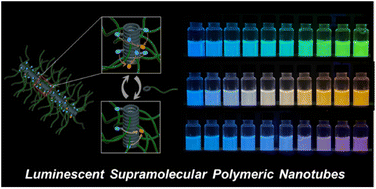
Polym. Chem., 2022,13, 4366-4371
https://doi.org/10.1039/D2PY00557C
Tunable and wavelength-gated reversible photopolymerization of quinolinone-based telechelic oligomers via [2π + 2π] cycloaddition
A quinolinone photoswitch enables nearly-reversible, wavelength-gated photopolymerization and depolymerization of telechelic oligomers. Tuning light wavelength, oxygen level, and concentration precisely modulates polymer growth and cleavage.
![Graphical abstract: Tunable and wavelength-gated reversible photopolymerization of quinolinone-based telechelic oligomers via [2π + 2π] cycloaddition](/en/Image/Get?imageInfo.ImageType=GA&imageInfo.ImageIdentifier.ManuscriptID=D5PY01021G&imageInfo.ImageIdentifier.Year=2026)
Polym. Chem., 2026, Advance Article
https://doi.org/10.1039/D5PY01021G
Degradable polyacetals and polyacetal/polycyclooctene Co-polymers from a novel dioxepin
A novel dioxepin polymerized via ring-opening metathesis polymerization leverages chain growth chemistry to prepare self-amplified degradable polymers.

Polym. Chem., 2025,16, 4136-4143
https://doi.org/10.1039/D5PY00484E
Incorporating polar oxazolidinones into polycyclooctadiene via frontal ring-opening metathesis polymerization
Polycyclooctadiene-based thermosets with polar oxazolidinone repeat units were synthesized via frontal ring-opening metathesis polymerization. Small amounts of polar functionality suppressed crystallization and greatly impacted mechanical properties.

Polym. Chem., 2025,16, 4144-4149
https://doi.org/10.1039/D5PY00721F
Polymer composites informatics for flammability, thermal, mechanical and electrical property predictions
Polymer composite performance depends significantly on the polymer matrix, additives, processing conditions, and measurement setups.

Polym. Chem., 2025,16, 3459-3467
https://doi.org/10.1039/D4PY01417K
Influence of para-substitution on the polymerisation kinetics of 2-phenyl-2-oxazolines
A series of cationic ring opening polymerisations (CROP) were conducted on a library of electronically diverse para-substituted 2-phenyl-2-oxazolines.

Polym. Chem., 2025,16, 3443-3449
https://doi.org/10.1039/D4PY01454E
Oxidation of polydithioacetals towards enhanced interchain interactions and oxidative stability
Oxidation of polydithioacetals to polysulfones by mCPBA increased the glass transition temperature (Tg) by over 140 °C and enhanced their stability in refluxing DMSO.

Polym. Chem., 2025,16, 3344-3350
https://doi.org/10.1039/D5PY00359H
Mechanically robust but dynamic elastomers as functional coatings based on dynamic covalent bonds and multiple noncovalent interactions
A mechanically robust but dynamic elastomer was designed as a functional coating to achieve enhanced mechanical performance and antimicrobial activity.

Polym. Chem., 2025,16, 3156-3163
https://doi.org/10.1039/D5PY00495K
Synthesis of poly(3-keto-D-glucal) via conjugate addition polymerization
Glycal-based monomers were synthesized and then used for conjugate addition polymerization to afford high molecular weight polymers. Subsequently, the polymers were subjected to mild deprotection conditions to afford water-soluble macromolecules.

Polym. Chem., 2025,16, 3051-3058
https://doi.org/10.1039/D5PY00444F
Poly(ε-L-lysine)-decorated particles with a tunable morphology by a combination of Ugi multicomponent polymerisation and RAFT-mediated PISA
We report herein the unprecedented combination of the Ugi multicomponent reaction (Ugi MCR) and Polymerisation-Induced Self-Assembly (PISA) to fabricate poly(ε-L-lysine) (PεLL) decorated amphiphilic nanoparticles.

Polym. Chem., 2025,16, 3041-3050
https://doi.org/10.1039/D5PY00384A
Yttrium-mediated ring-opening polymerization of functionalizable dihydrocarvide: tunable terpene-based polyesters using grafting from and block copolymerization strategies
Poly((−)-dihydrocarvide) is synthesized via yttrium-mediated ring-opening polymerization. Block copolymerization and functionalization yield semi-crystalline and brush polymers, highlighting its versatility in copolymer design.

Polym. Chem., 2025,16, 2910-2922
https://doi.org/10.1039/D5PY00322A
Impact of imine bonds on the electronic properties of degradable carotenoid-based conjugated polymers
Carotenoids are ideal building blocks for degradable π-conjugated polymers due to their intrinsic single-molecule conductance and well-documented degradation pathways.

Polym. Chem., 2025,16, 2817-2828
https://doi.org/10.1039/D5PY00235D
Transparent diblock copolymer nanoparticle dispersions via efficient RAFT emulsion polymerisation in ionic liquid
The first RAFT emulsion polymerisation formulation in ionic liquid yields transparent diblock copolymer nanoparticle dispersions with improved efficiency and control.

Polym. Chem., 2025,16, 2767-2777
https://doi.org/10.1039/D5PY00076A
Generation of topologically defined linear and cyclic DNA bottle brush polymers via a graft-to approach
Plasmid-derived DNA bottlebrush polymers with linear and circular topologies are synthesized via aqueous grafting of PEG. These constructs exhibit tunable mechanics, enhanced nuclease resistance, and preserve DNA structure and circularity.

Polym. Chem., 2025,16, 2646-2658
https://doi.org/10.1039/D5PY00082C
Synthesis of butadiene-derived polyolefin graft copolymers and their crystallization behaviors
This work reports the synthesis of semicrystalline polyolefin-based graft copolymers and understanding their crystallization behaviors and blend compatibilization performance for potentially addressing mixed polyethylene and polypropylene.

Polym. Chem., 2025,16, 2530-2542
https://doi.org/10.1039/D5PY00243E
Corona-shaped two-dimensional polyaramid derivatives for poly(ethylene oxide)-based all-solid-state lithium batteries
Unique corona-shaped two-dimensional polyaramid (2DPA) derivatives were designed and synthesized for poly(ethylene oxide) (PEO)-based solid polymer electrolytes to improve the overall performance of solid-state lithium batteries.

Polym. Chem., 2025,16, 2421-2427
https://doi.org/10.1039/D5PY00046G
Cyclic thioacetal carbonates for dual-stimuli degradable poly(vinyl ether)s with cleavable thioacetal and carbonate bonds evenly distributed in the main chains by cationic degenerative chain-transfer copolymerization
Dual-degradable poly(vinyl ether)s were prepared by cationic degenerative chain-transfer copolymerization of macrocyclic thioacetal carbonate and vinyl ether and degraded to low- and controlled-molecular-weight products by acid and base catalysts.

Polym. Chem., 2025,16, 2389-2400
https://doi.org/10.1039/D5PY00054H
Directed dihydroxylation of a poly(cyclooctadienol) toward densely-hydroxylated polyol adhesives
Directed dihydroxylation of an unsaturated polymer yields polyols with a dense array of alcohol groups toward applications in adhesives.

Polym. Chem., 2025,16, 2128-2132
https://doi.org/10.1039/D5PY00044K
Harnessing ene-type and stereochemistry to control reaction kinetics and network architecture in thiol–ene photopolymerizations using maleate and fumarate-derived monomers
Bioacid-derived trienes show differences in the relative kinetics of thiol-mediated step-growth and chain-growth processes.

Polym. Chem., 2025,16, 1829-1845
https://doi.org/10.1039/D4PY01361A
Ring-opening metathesis polymerization of (oxa)norbornenes with sulfonate, sulfone, and sulfoxide sidechains
Metathesis of (oxa)norbornene monomers with sulfonate, sulfone, or sulfoxide sidechains demonstrate varied behavior from controlled, rapid ROMP to single unit monomer insertion.

Polym. Chem., 2025,16, 1653-1658
https://doi.org/10.1039/D4PY01307G
Conversion of oligo(ethyleneglycol)s into non-toxic highly selective biocompatible poly(ethyleneglycol)s: synthesis, antimicrobial and antibiofilm activity
This article reports a green and affordable synthetic approach to prepare a library of ten multifunctional antimicrobial poly(ethylene glycol)s and their structure-property relationship.

Polym. Chem., 2025,16, 1584-1594
https://doi.org/10.1039/D4PY01302F
A pinch of silver salt to enable rac-lactide ring-opening polymerisation at room temperature using Ti-salen complexes
Exploiting non-covalent interactions (NCIs) has become a powerful tool in catalyst design, including those for polymerisation reactions.

Polym. Chem., 2025,16, 1503-1508
https://doi.org/10.1039/D4PY01319K
Stoichiometric effects on bulk stress relaxation to enhance reprocessability in covalent adaptable networks
We explored the effect of stoichiometry variation in CAN on bulk relaxation speed and mechanical integrity over thermal reprocessing.

Polym. Chem., 2025,16, 1031-1043
https://doi.org/10.1039/D5PY00013K
Frontal polymerization of thiol–acrylate covalent adaptable networks
Herein, energy-efficient curing is combined with the versatility of dynamic polymer networks. The resulting materials show fast stress relaxation via transesterification reactions and can be reprocessed and reshaped at elevated temperatures.

Polym. Chem., 2025,16, 963-971
https://doi.org/10.1039/D4PY01106F
3D printable biopolymers as pelvic floor scaffolds
Our polyvinyl alcohol feedstock was prepared through carbic anhydride functionalization, UV curing during direct ink writing, and base treatment. The scaffold exhibited mechanical properties similar to pelvic floor tissue.

Polym. Chem., 2025,16, 345-355
https://doi.org/10.1039/D4PY01103A
Controlling thiyl radical polymerization via in situ desulfurization
A strategy that tailors propagating species in situ using trivalent phosphorus enables thiyl radical polymerizations to be controlled by the RAFT agent, thereby facilitating the production of polymers with well-defined architectures.

Polym. Chem., 2025,16, 174-180
https://doi.org/10.1039/D4PY01140F
Effects of crosslink density and plasticizer on thermorheological properties of dissociative guanidine-based covalent adaptable networks
This work describes the effect of varying crosslink density and plasticizer loading on covalent adaptable networks that have equal amounts of reactive functionalities.

Polym. Chem., 2025,16, 52-61
https://doi.org/10.1039/D4PY01124D
Reducing agent-triggered templated synthesis of a dynamic covalent poly(disulfide)s nanonetwork: remarkable tuning in noncovalent encapsulation stabilities and cargo release
We reported a methodology for the reducing agent mediated poly(disulfide)s nanonetwork formation from lipoic acid based monomer in water as a highly stable potential delivery vehicle for chemotherapeutic applications.

Polym. Chem., 2024,15, 5007-5015
https://doi.org/10.1039/D4PY01109K
Long afterglow epoxidized soybean oil polymer composites with reversible dynamic cross-linking for intelligent coating
The intelligent coating possesses a crack monitoring function in real time, with desirable shear strength and self-healing, and exhibits rapid degradation ability.

Polym. Chem., 2024,15, 4982-4992
https://doi.org/10.1039/D4PY00857J
Sequence-defined structural transitions by calcium-responsive proteins
Recombinant protein engineering accelerated the synthesis of sequence-defined, calcium-responsive biopolymers. A mutation panel of repeats-in-toxin (RTX) proteins revealed sequence-dependent disorder, calcium sensitivity, and structural transitions.

Polym. Chem., 2024,15, 4864-4874
https://doi.org/10.1039/D4PY00907J
Customizing STEM organogels using PET-RAFT polymerization
PET-RAFT polymerization was used to modify STEM organogels, while degradable linkers enabled the characterization of the resulting block copolymers.

Polym. Chem., 2024,15, 3907-3915
https://doi.org/10.1039/D4PY00874J
Designing dual-domain thermoplastic elastomers from ABA triblock copolymers: introducing bond-exchangeable subdomains into B-block strands
Incorporating self-aggregated quaternized pyridine cross-links into the middle block of poly(styrene)-b-poly(butadiene)-b-poly(styrene) triblock copolymer enables preparation of dual-domain thermoplastic elastomers with bond-exchangeable subdomains.

Polym. Chem., 2024,15, 3854-3863
https://doi.org/10.1039/D4PY00858H
A bioinspired layered hydrogel actuator viaL-ascorbic acid-triggered interfacial self-growth from a stiff hydrogel
Inspired by the reversible deformation of pine cones, a thermo-responsive layered hydrogel actuator with asymmetric structural layers was prepared by crafting Vc-triggered interfacial radical polymerization from a stiff hydrogel.

Polym. Chem., 2024,15, 3787-3794
https://doi.org/10.1039/D4PY00848K
Facile synthesis of asymmetric molecular brushes with triple side chains using a multivalent monomer strategy
Heterografted molecular brushes comprising three different brushes were synthesized based on the Br-acrylate-epoxide multivalent monomer strategy, which enabled the fabrication of 2D platelets and the stabilization of different emulsions.

Polym. Chem., 2024,15, 3552-3562
https://doi.org/10.1039/D4PY00656A
UV-light crosslinked photocatalytic polymer gels for batch and continuous flow reactions
This article describes the synthesis and characterization of a UV-crosslinked Eosin Y-photocatalytic gel and studies its performance in the oxidation of thioanisole in batch and flow reactors.

Polym. Chem., 2024,15, 2634-2641
https://doi.org/10.1039/D4PY00313F
A proof-of-concept study on a fully biobased and degradable polymer network based on vanillin and myrcene
A vanillin monomer featuring a carbonate linkage in its center was synthesized and used to prepare degradable biobased polymer networks.

Polym. Chem., 2024,15, 2240-2252
https://doi.org/10.1039/D4PY00269E
Vanillin-based dual dynamic epoxy building block: a promising accelerator for disulfide vitrimers
A dual-dynamic bio-based epoxy building block (DDBB) with both imine and disulfide bonds synthesized from cystamine and vanillin showed accelerated dynamic exchanges in disulfide vitrimer formulations.
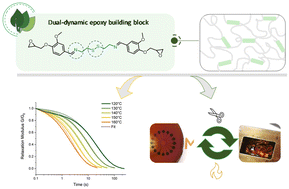
Polym. Chem., 2024,15, 1347-1357
https://doi.org/10.1039/D4PY00038B
Polymerization-induced self-assembly of (2-(4-vinylbenzyl)iso-indoline-1,3-dione) for the synthesis of hydrazine responsive block copolymer nanoparticles
Hydrazine-responsive block copolymer nanoparticles with a phthalimide core are synthesized via reversible addition–fragmentation chain transfer (RAFT)-mediated dispersion polymerization-induced self-assembly.
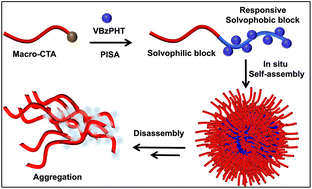
Polym. Chem., 2024,15, 1043-1051
https://doi.org/10.1039/D4PY00073K
Lewis acid-induced homo- and heterogeneous nickel catalysts for ethylene polymerization and copolymerization with polar monomers
By introducing soluble and supported Lewis acids, homogeneous and heterogeneous nickel-catalyzed ethylene (co)polymerization was designed and studied.
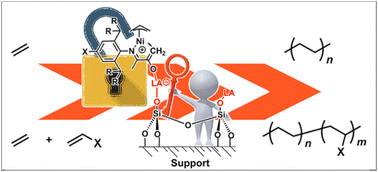
Polym. Chem., 2024,15, 631-638
https://doi.org/10.1039/D3PY01266B
π-Face strapped monomers enable self-stabilized hyperbranched π-conjugated polymer particles
Cycloalkyl-strapped repeat units hinder inter-chain interactions and guide the imine condensation polymerization of A2 + B3 monomers into solution-dispersible and processable π-conjugated hyperbranched polymers instead of an insoluble network.
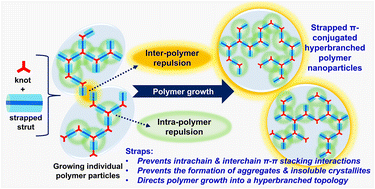
Polym. Chem., 2024,15, 422-430
https://doi.org/10.1039/D3PY01158E
Strands vs. crosslinks: topology-dependent degradation and regelation of polyacrylate networks synthesised by RAFT polymerisation
The influence of the cleavable bond location on degradation and reformation of poly(n-butyl acrylate) networks synthesised by RAFT polymerisation was investigated and revealed that cleavable backbones lead to more efficient network reversibility.

Polym. Chem., 2023,14, 5166-5177
https://doi.org/10.1039/D3PY01008B
Multi-responsive nanogels with tunable orthogonal reversible covalent (TORC) core-crosslinks for AND-gate controlled release
Installation of TORC core-crosslinks in polymer nanogels is accomplished in a single pot using photo-controlled atom transfer radical polymerization-induced self-assembly (PhotoATR-PISA) resulting in nanogels with AND-gate cargo release behavior.

Polym. Chem., 2023,14, 4957-4969
https://doi.org/10.1039/D3PY00922J
Bulk depolymerization of graft polymers based on trans-cyclobutane-fused cyclooctene
Graft polymers with various sidechain lengths and grafting densities are prepared using trans-cyclobutane-fused cyclooctene macromonomers; the solvent-free depolymerization of these graft polymers in the presence of a ruthenium catalyst is studied.

Polym. Chem., 2023,14, 4927-4932
https://doi.org/10.1039/D3PY00812F
Vat 3D printing of full-alginate hydrogels via thiol–ene reactions towards tissue engineering applications
Different synthetic strategies are explored to functionalize alginate with thiol and alkene groups. In this way an innovative full-alginate ink for digital light processing printers, based on the more biocompatible thiol–ene chemistry, is proposed.

Polym. Chem., 2023,14, 4856-4868
https://doi.org/10.1039/D3PY00902E
Ring-opening terpolymerisation of phthalic thioanhydride with carbon dioxide and epoxides
The ring-opening terpolymerisation of phthalic thioanhydride with CO2 and epoxides leads to the formal incorporation of (photo)chemically labile thioester breaking points into the parent poly(ester-carbonate) backbone.
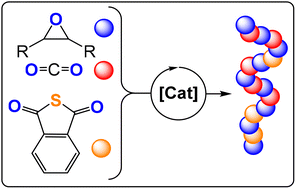
Polym. Chem., 2023,14, 4848-4855
https://doi.org/10.1039/D3PY01022H
Polymer grafting on nitrone functionalized green silica via “grafting from” and “grafting to” approaches through enhanced spin capturing polymerization and a 1,3-dipolar cycloaddition reaction
Unlocking surface nitrones on green silica for innovative polymer grafting: Exploring "grafting from" and “grafting to” via enhanced spin capturing polymerization (ESCP) and 1,3-dipolar cycloaddition.

Polym. Chem., 2023,14, 4547-4559
https://doi.org/10.1039/D3PY00712J
Synthesis and characterization of a ruthenium-containing copolymer for use as a photoredox catalyst
We present a [Ru(bpy)2(dmbpy)]2+- and pyrene-based photocatalytic PMMA that enables photoredox-energy transfer to achieve the C–H arylation of electron deficient aryl bromides.

Polym. Chem., 2023,14, 4560-4568
https://doi.org/10.1039/D3PY00428G
Water soluble non-conjugated fluorescent polymers: aggregation induced emission, solid-state fluorescence, and sensor array applications
In this work, two water soluble fluorescent non-conjugated polymers have been designed and synthesized.
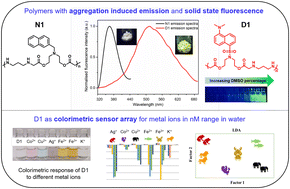
Polym. Chem., 2023,14, 3309-3316
https://doi.org/10.1039/D3PY00357D
Facile access to diverse polyethylenes via neutral salicylaldiminato nickel catalysts
A new family of neutral salicylaldiminato nickel(II) catalysts enables ethylene polymerization to produce diverse polyethylene materials including polyethylene plastic, elastomer, wax and oil.

Polym. Chem., 2023,14, 3196-3202
https://doi.org/10.1039/D3PY00450C
Mechanochemical reactivity of a multimodal 2H-bis-naphthopyran mechanophore
A 2H-bis-napthopyran (2H-BNP) mechanophore generates an unusually stable bis-merocyanine product upon mechanical activation.
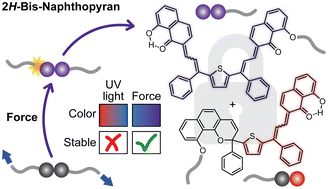
Polym. Chem., 2023,14, 2717-2723
https://doi.org/10.1039/D3PY00344B
Installation of the adamantyl group in polystyrene-block-poly(methyl methacrylate) via Friedel–Crafts alkylation to modulate the microphase-separated morphology and dimensions
We present the polystyrene block post-polymerization modification of PS-b-PMMA through Friedel–Crafts alkylation with adamantanols to modulate its microphase-separated morphology and dimensions.
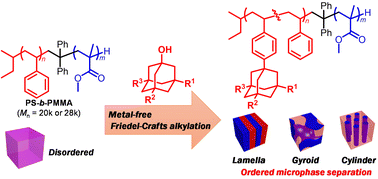
Polym. Chem., 2023,14, 2675-2684
https://doi.org/10.1039/D3PY00113J